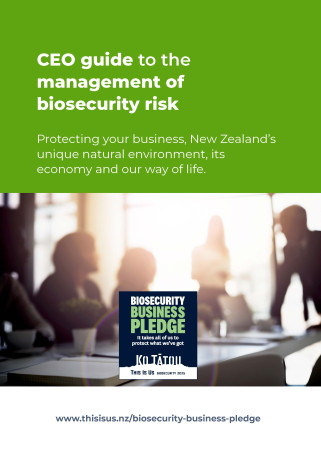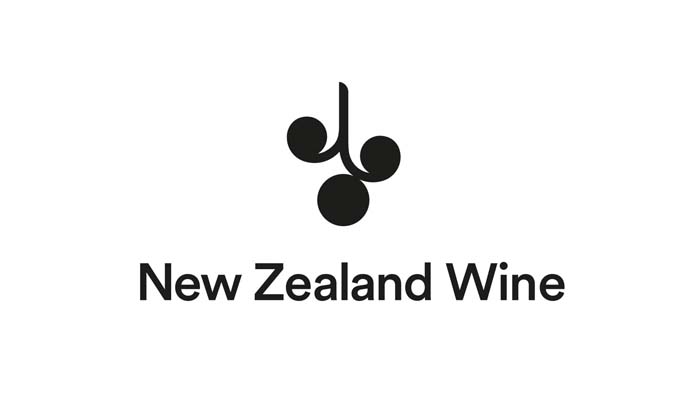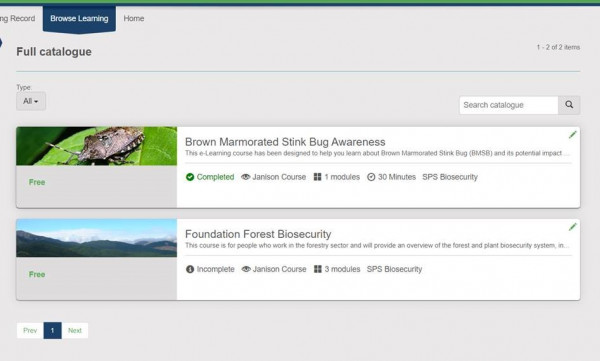Business tools and templates
August was the Pledge’s Awareness month
Throughout August, we asked members to come together and support their customers, staff, suppliers and stakeholders to understand the importance of biosecurity and what good biosecurity practice looks like.
We produced some new materials that you can still use, including:
- Unwanted pest posters
- Social media posts with supporting images
- New training module
- Quiz questions
- Unwanted pest cards
Unwanted pest posters
We have also developed posters that you can easily print and use. Please feel free to share a link to these materials with any other businesses, customers, or suppliers as we work together to equip all businesses to help keep biosecurity risks out of New Zealand.
Biosecurity Governance for New Zealand’s board tables
Accountability for biosecurity risks should sit at the most senior levels of leadership and be on risk registers with regular reporting and discussion at senior levels. The CEO Guide to Managing Biosecurity Risk and Biosecurity Considerations for Boards are guidelines designed to support businesses in taking top-down leadership through the development of high-level biosecurity risk plans that can be tailored for individual companies. These guidelines are valuable tools that will shape efforts to protect our businesses, New Zealand’s unique environment and the economy.
The guidelines were co-designed by members of the Pledge in consultation with a selection of Pledge chief executives and governors. If you have any questions about these guidelines or the Biosecurity Business Pledge, contact Debbie Teale, executive director of the Pledge debbie@debbieteale.co.nz or 021 811 866.
 |
 |
| CEO guide to the management of biosecurity risk [PDF, 320KB] | Biosecurity considerations for Boards [PDF, 415KB] |
Kiwifruit Vine Health (KVH) biosecurity resources

Recognising that all 5 million of us are part of our biosecurity system, Kiwifruit Vine Health (KVH) have developed a number of resources for use by both growers and the general public including Kiwifruit Growers Biosecurity Guidelines and a helpful guide for growers, detailing the likely sequence of events if a fruit fly response was to occur in a kiwifruit growing region.
“The Kiwifruit industry is worth billions of dollars and with the public onboard – knowing the importance of biosecurity and taking action when they should - we can help protect the things associated with the industry that are important to us all as a community, not just orchards but businesses, jobs, and people’s livelihoods,“ says Stu Hutchings, Chief Executive of Kiwifruit Vine Health.
KVH works with growers and all sorts of organisations across the kiwifruit industry (like Zespri and post-harvest companies) to raise awareness about what to look out for and what to do if anything out of the ordinary is found on plants in orchards, in nurseries and in gardens.
They’re strongly focused on leading preparedness for biosecurity risks to the kiwifruit industry - identifying unwanted pests and diseases, working to keep them out of the country, and prepare for what the industry needs to do should they get here.
“Every community member makes a difference. The more sets of eyes we have on the lookout for unusual disease symptoms, and pests, the better off we are because it increases the likelihood of damaging threats not only being discovered, but being found early enough for us to limit impacts. “
Check out KVH’s biosecurity resources:
- Kiwifruit Growers Biosecurity Guidelines [PDF, 28MB]
- A helpful guide for growers, detailing the likely sequence of events if a fruit fly response was to occur in a kiwifruit growing region.
- This booklet which provides guidance about how everyone in or close to the kiwifruit community can help identify biosecurity risks and address them.
- Best practice poster when hosting or visiting an orchard event [PDF, 686KB]
- Poster for people visiting a kiwifruit orchard who have been overseas recently [PDF, 695KB]
- New on-orchard biosecurity planning video: matches (in both artwork and messaging) the kiwifruit growers biosecurity planning booklets [PDF, 5.8MB] that all growers must complete for each property
- New kiwifruit growers ‘unwanted pest’ calendar [PDF, 27MB] for 2023
Fonterra's biosecurity requirements for travellers
Biosecurity Business Pledge member Fonterra has shown leadership in signing up and being proactive in their commitment to integrate biosecurity practices into their operations and supply chains.
They’ve developed these requirements that detail the expectations they have for their travellers.
Fonterra’s biosecurity key principles aim to reduce the spread of diseases and pests that impact animals or the feed crops they rely on and ensuring high standards of animal health and welfare and biosecurity. This is vital to help secure strong and thriving rural communities for future generations.
Biosecurity e-learning Fonterra has developed for its corporate travellers
Fonterra has turned the limited occurrence of international corporate travel during COVID times into an opportunity to strengthen systems to build corporate traveller biosecurity awareness. An e-learning tool has been developed to walk travellers through the global context for biosecurity, key risks associated with travel, and good practices.
The e-learning covers pre-departure planning and well as pre-return practices. Particular guidance is given on equipment taken offshore and its disinfection before returning to New Zealand. Potential for contamination of everyday footwear is highlighted – an item that is easily overlooked.
The tool is linked to the Fonterra travel booking system and includes an acknowledgement section upon completion. In its design attention was paid to communication formats which would support good learning retention of the information conveyed. A simulated text message exchange is included to summarise and reinforce the information conveyed.
Their biosecurity reference card for travellers summaries some of the tips covered in the e-learning tool.
NZ Wine Biosecurity Resources

The NZ Wine team has created some new biosecurity resources to ensure healthy vineyards through positive biosecurity actions. These include a Pest and Disease Identification Guide for the most unwanted in our vineyards and a guide to those already present.
Check them all out on the NZ Wine website:
Auckland Airport's commitment to protect our border
Airport case study
Auckland Airport is committed to protecting our border from unwanted biosecurity pests.
For biosecurity reasons all aircraft cabin waste must be processed at the border and sterilised on site at Auckland Airport. In 2015, in a world first for biosecurity and airport waste reduction, Auckland Airport, in conjunction with OCS – a facilities management company specialising in sustainable solutions, and MPI, developed an airside transitional waste facility (TWF) that segregates and sorts cabin waste from a number of airlines.
Waste is sorted according to MPI biosecurity requirements into items which can be reused, recycled and reconstituted into totally different products such as composite building materials, without compromising biosecurity, and those that must be quarantined and destroyed for biosecurity reasons.
By drastically reducing the amount of aircraft cabin waste sent to landfill not only have they increased sustainability and reduced waste, they’ve also achieved a good outcome for New Zealand’s biosecurity.
Auckland Airport training
Pledge member, Auckland International Airport (AIAL), have made their online biosecurity awareness training module available to all.
If you’d like to discuss this resource or designing a similar tool for your business, contact Shaun at Auckland Airport, Shaun.Sie@aucklandairport.co.nz.
SPS Biota – training modules
As a Biosecurity Readiness and Response Panel member, SPS Biota has three publicly available, free to access online learning courses to help promote understanding and action around biosecurity:
Brown Marmorated Stink Bug Awareness
Learn about Brown Marmorated Stink Bug (BMSB) and its potential impact on New Zealand. BMSB is not present in New Zealand and this course will teach you what to do if you suspect you have found one.
Get an overview of the forest and plant biosecurity system including why biosecurity is important for all New Zealanders. This course will teach you how you can help protect the forests we work and play in, through good biosecurity.
Learn about the spongy moth, its potential impacts, how to identify it and what to do if you think you’ve found one.
When a participant clicks on the link they will need to register to be able to access the modules, once registered they can logon.

Once logged on the can access the modules and begin their learning – see below

Biosecurity in New Zealand: An introduction
Biosecurity New Zealand has produced Protecting New Zealand, a brochure designed to raise awareness of our world leading, multi layered biosecurity system. It can be used by businesses starting out on their biosecurity journey and as a resource to educate staff, suppliers and the broader supply chain of the various risks associated with the movement of goods into and around New Zealand; the systems in place should a pest or disease get past our border and the associated economic implications of such a threat.
Get started with this introduction to New Zealand’s biosecurity system and share it with your networks. Everyone has a role in managing risk and protecting Aotearoa New Zealand.
Pests and diseases
Auckland Airport Resources
Each month Auckland Airport displays a ‘Pest of the Month’ poster throughout their offices and site to raise biosecurity awareness among team members. The Airport have kindly agreed to share this resource and welcome you extracting or re-branding any part of the content to suit your purposes and channels.
Note that if you think you’ve found an exotic pest or disease, this can be reported to Biosecurity New Zealand at bit.ly/3kF8NKK or by freephone 0800 80 99 66.
- Queensland fruit fly [JPG, 382KB]
- Sawyer beetle [PNG, 325KB]
- Spongy moth [JPG, 1.2MB]
- Brown Marmorated Stink Bug [JPG, 300KB]




Social media posts with supporting images
We have put together some posts for you pick what may be suitable for your audience and channels. The images (tiles which are at 1080 x1080px for social media) can be interchanged to suit your purposes and there are a few extra to choose from at the bottom.
Social media posts with supporting images [DOC, 1.5MB]
New training module
If you run a Transitional Facility (TF), then this new Biosecurity New Zealand training module is designed for you and your teams. It will help build an understanding about what biosecurity is and what actions they need to take if they find something out of the ordinary. If TFs have their own Learning Management System, Biosecurity New Zealand can give you the whole package and you can then track completion your side. If this is of interest, then email APTraining@mpi.govt.nz
Biosecurity Awareness module - Ministry for Primary Industries
The training module is relevant for all – not just TFs.
Quiz questions
Do you want to host a lunch time quiz session and test your teams on their biosecurity knowledge? Here are some starters to kick you off.
Biosecurity Awareness Month Quiz Questions [PDF, 127KB]
Unwanted pests and disease ID cards
The following cards identify some of our nation’s higher biosecurity risks. Should any of these get across our border, they would be disruptive to individual businesses and sectors, the economy, our environment and even our way of life. We all have a role in preventing pests and diseases from getting into New Zealand or helping stop their spread if they do get here.
Members of the Biosecurity Business Pledge asked for some simple visual cards that make it easy to identify a pest or disease along with what to do if you find them. That’s why the Biosecurity Business Pledge, in collaboration with Biosecurity New Zealand, produced these cards that you can use to build awareness in your workplace. We encourage you to print copies from the PDF file for your workplace. We have a limited number of printed sets, if you would like a set please contact jo.darby@mpi.govt.nz
An introduction to some unwanted foreign plant and animal pests and diseases [PDF, 8.5MB]